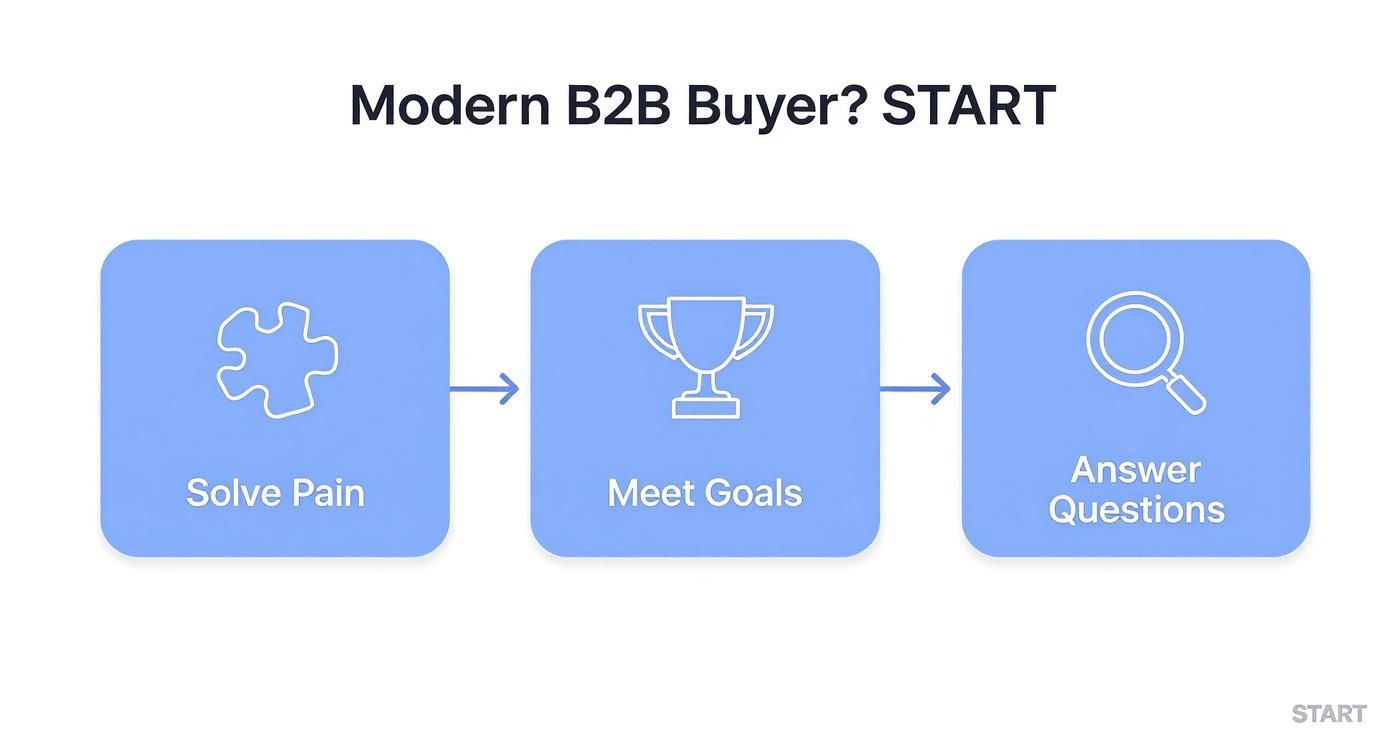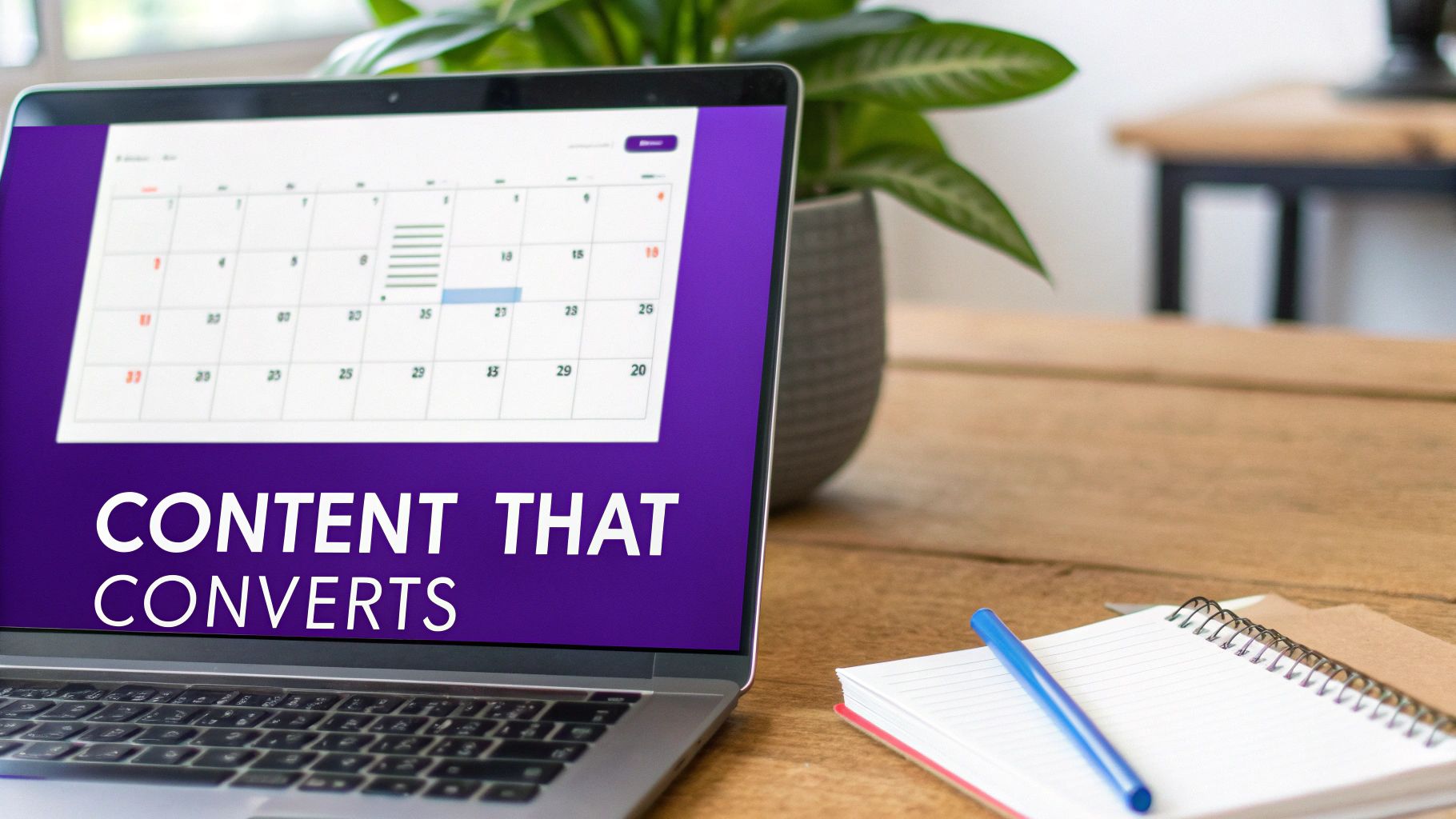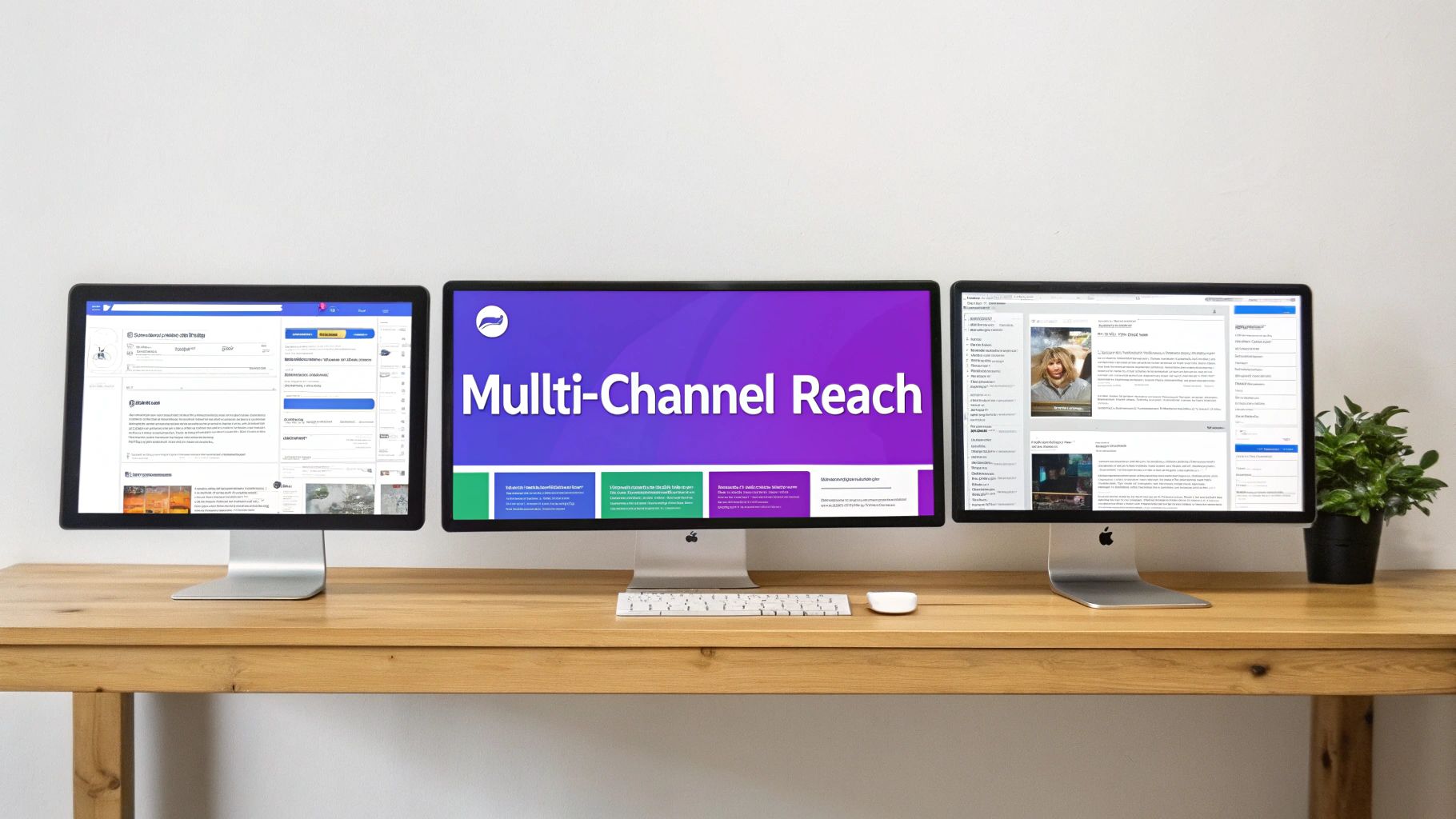Let's be honest: digital marketing for B2B companies isn't just about running a few ads and hoping for the best. It’s a completely different ball game than B2C. You're not trying to cast a wide net; you're building long-term relationships with businesses, navigating complex buying committees, and proving a clear return on investment over a much longer sales cycle. In fact, research shows that the average B2B sales cycle takes over 100 days, making a sustained, data-driven digital strategy absolutely essential.
Understanding the Modern B2B Buyer
Before you spend a single dollar on a campaign, you have to get inside the head of your customer. The old-school, linear sales process is dead. Today’s B2B buying journey is a self-directed, winding road where multiple stakeholders do a ton of research long before they ever think about picking up the phone.
In fact, according to Gartner, buyers complete nearly 85% of their purchasing decision on their own—digging into solutions, ranking their options, and setting requirements—all before engaging with a sales rep. This puts the power squarely in their hands and makes your digital presence absolutely critical.
Building Your Ideal Customer Profile
To connect with this new breed of buyer, you need to go way beyond basic demographics. A true Ideal Customer Profile (ICP) is a detailed blueprint of the company that gets the most value from what you sell. This isn’t just about industry or employee count; it’s about understanding their day-to-day realities, their growth ambitions, and the specific, nagging problems that keep them up at night.
A rock-solid ICP acts like a filter, ensuring your marketing budget is only spent reaching accounts that are actually a good fit—the ones likely to become high-value, long-term partners. For instance, a B2B SaaS company in the logistics space saw a 40% jump in qualified leads after they got serious about their ICP. They stopped trying to sell to every transportation company out there. Instead, they focused on mid-sized firms bogged down by outdated fleet management systems. This laser focus allowed them to tailor every single piece of content to solve that one urgent problem.
Mapping the Buyer's Journey
Once you know which companies to target, the next step is to understand the people inside them. A typical B2B buying committee is a mix of personalities with very different priorities:
- The End-User: They just want to know if it will make their daily job easier.
- The Technical Specialist: They're focused on integration, security, and the nitty-gritty specs.
- The Financial Decision-Maker: All they care about is the bottom line—ROI, cost savings, and business impact.
Each of these personas needs to hear a different message at different times. If you can map out their individual motivations and pain points, your marketing will be infinitely more effective. To get a much deeper look at this process, check out our guide on customer journey mapping for your B2B marketing strategy.
Getting this foundation right is easily the most important part of building a B2B marketing program that actually works. If you're ready to define your ICP and map the buyer's journey, contact us for a strategy session.
Choosing Your B2B Marketing Strategy
Your digital marketing strategy is the blueprint for everything you do. It dictates how you spend your budget, the content you create, and even how your sales and marketing teams collaborate. In the B2B world, two powerful approaches dominate: the broad-funnel Demand Generation and the hyper-focused Account-Based Marketing (ABM).
Let's use a fishing analogy. Think of Demand Generation as casting a wide net. Your goal is to catch as many fish as you can by attracting a high volume of potential customers. You do this with valuable content, SEO, and paid media, building brand awareness and filling the top of your funnel with a steady stream of leads.
On the other hand, Account-Based Marketing (ABM) is like spear fishing. You’re not casting a net; you’re using a spear to target specific, high-value fish. With ABM, your marketing and sales teams work together to identify a shortlist of dream-fit companies, then launch highly personalized campaigns to engage key decision-makers within those exact accounts.
This infographic breaks down what motivates your modern B2B buyer, which should be the starting point for whichever strategy you choose.

As you can see, B2B buyers are looking to solve a pain, meet a goal, or answer a question. Your strategy must directly speak to one of these core needs.
When To Use Demand Generation
Demand generation is usually the right place to start for companies with a broad target market or those needing to ramp up lead volume quickly. If your product solves a common problem for a wide variety of businesses, the "wide net" approach is the most efficient way to capture interest and build a healthy pipeline.
Businesses with a lower average contract value (ACV) tend to see the most success here, as the model is built for volume and efficiency. HubSpot is a master of this, offering a massive library of free blogs, templates, and courses. This content attracts millions of visitors, many of whom eventually become paying customers, filling their funnel at an incredible scale. Their strategy has been so effective that their organic content generates over 1.5 million leads per year.
When To Deploy Account-Based Marketing
ABM becomes the go-to strategy when you're selling high-value, complex solutions to a finite number of large enterprise accounts. When a single deal could be worth six or seven figures, it just makes sense to pour significant resources into winning that specific business. The numbers back it up: 87% of marketers report that ABM delivers a higher ROI than other marketing activities.
A fantastic success story comes from the software company Snowflake. They used ABM to target specific enterprise accounts in the financial services industry. By creating custom content, hosting exclusive roundtables, and running personalized ad campaigns aimed at decision-makers in target banks, they landed the massive contracts that fuelled their early growth.
The core difference is simple: Demand generation focuses on attracting many individual leads, while ABM treats each target account as its own market.
To help clarify which path is right for you, here’s a side-by-side comparison.
Demand Generation vs Account-Based Marketing (ABM)
| Attribute | Demand Generation | Account-Based Marketing (ABM) |
|---|---|---|
| Target | Broad audience of individual leads | Specific, named high-value accounts |
| Goal | Generate a large volume of leads | Engage & win a small number of key accounts |
| Analogy | Casting a wide net | Spear fishing |
| Metrics | Leads, MQLs, Cost Per Lead (CPL) | Account Engagement, Pipeline Velocity, Win Rate |
| Content | Broadly appealing (blogs, ebooks, webinars) | Highly personalized (custom reports, direct mail) |
| Sales/Marketing | Aligned, but often sequential (MQL handoff) | Fully integrated and collaborative from the start |
| Best For | Lower ACV, broad market, scaling lead volume | High ACV, complex sales, defined target list |
Ultimately, the choice isn't always binary. Many successful companies blend the two, running broad demand generation programs to build awareness while deploying targeted ABM campaigns for their most strategic accounts. Understanding both allows you to build a flexible and powerful B2B marketing engine.
Ready to define the right strategy for your business? Contact us to discuss whether a demand generation, ABM, or hybrid approach will drive the most growth for you.
Creating B2B Content That Drives Decisions
If your strategy is the blueprint, then your content is the steel and concrete you build with. In B2B marketing, content is how you earn trust. It’s the way you prove you know your stuff, answer the tough questions, and walk a prospect from a fuzzy problem to a clear, confident buying decision.
But not all content is created equal. The trick is to map every single asset to a specific stage in the buyer's journey.

Think of the sales funnel like a real-life conversation. You wouldn’t walk up to a stranger and immediately ask for a huge commitment. You'd start with a broad topic, build some common ground, and only get more specific once you've established a bit of trust. Your content should work exactly the same way.
Top of the Funnel (ToFu): Capturing Attention
At the top of the funnel, your audience isn't looking for you or your product. They're just becoming aware they have a problem, but they have no idea what the solution looks like yet. Your job here is to attract and educate them with valuable, no-strings-attached content that speaks directly to their pain points.
This is where insightful blog posts and short, snappy videos really shine. And it’s no surprise that content marketing is still the bedrock of B2B digital strategies—it just flat-out works. Around 84% of B2B marketers build brand awareness with their content, and blogs are the go-to distribution channel for 76% of them. With today’s buyers conducting an average of 12 online searches before they even think about talking to a brand, this top-funnel content is non-negotiable if you want to be found.
For a deeper dive, check out some proven content marketing best practices that will help you cut through the noise.
- Insightful Blog Posts: Tackle common industry questions or challenges head-on.
- Short-Form Videos: Break down a complex idea or offer a quick, practical tip.
- Infographics: Turn dense data and stats into something people can actually digest and share.
The goal here is simple: become a go-to resource long before a purchase is even on the table.
Middle of the Funnel (MoFu): Building Credibility
Once you’ve got their attention, the middle of the funnel is where you start building real credibility. People at this stage are actively evaluating their options. They need more than just a blog post; they need proof that you truly understand their world and have a legitimate solution.
This is the perfect spot for more substantial, in-depth content.
Webinars and original research reports are powerhouse MoFu assets. Why? Because they demand something in return—a prospect's contact information—in exchange for high-value insights. This simple trade effectively turns an anonymous visitor into a qualified lead.
Take a B2B SaaS company that sells project management software. They launched a webinar series focused on "Improving Remote Team Productivity." They didn't just hawk their software; they offered real, actionable frameworks and expert advice. The result? They increased their sales-qualified leads by a massive 60%, proving that valuable, educational content pays off.
Bottom of the Funnel (BoFu): Closing the Deal
At the bottom of the funnel, your prospect is ready to pull the trigger. They’ve done their homework, they've weighed their options, and they've narrowed it down to a handful of vendors. Your content now needs to be laser-focused, removing any final shred of doubt and making an undeniable case for why your solution is the only choice.
It’s time to shift from educating to demonstrating.
- Compelling Case Studies: Show, don't just tell. Detailed case studies with real, hard numbers provide the social proof that decision-makers are desperately looking for. In fact, 79% of B2B buyers say case studies are the most influential content in their purchasing decision.
- Product Demos: Give them a direct look at your solution in action, ideally tailored to their specific use case.
- Free Trials or Consultations: Let potential buyers experience the value for themselves. This removes the final barrier and makes the decision easy.
By thoughtfully mapping your content to each of these stages, you create a seamless journey that builds unshakable trust and guides buyers toward a decision they can feel good about.
Ready to build a content engine that turns prospects into profitable customers? Contact us to develop a content strategy that drives measurable results.
Activating B2B Digital Marketing Channels
Right, you've got your strategy nailed down and your content is ready to go. Now for the exciting part: getting it in front of the right people. This is where the rubber meets the road, turning all that careful planning into a steady, predictable stream of qualified leads.
Great distribution is what separates a brilliant strategy on paper from a profitable one in the real world.

This isn't about blasting your message everywhere. It's about being surgical—showing up in the right places, at the right time, with a message that clicks. We’ll focus on the true powerhouse channels for digital marketing for B2B, showing you how to capture active demand, re-engage high-value prospects, and build the kind of trust that closes deals.
Mastering B2B Search Engine Optimization
For B2B companies, Search Engine Optimization (SEO) is so much more than chasing broad keywords. The real money is in capturing high-intent traffic from prospects who are actively looking for the exact solution you provide. That means zeroing in on long-tail keywords that signal someone is deep in the buying process.
Consider the difference. A search for "logistics software" is vague—it could be a student, a researcher, anyone. But a search for "logistics software for mid-sized e-commerce" is from someone with a specific problem, and likely a budget to solve it. When you create content optimized for these precise phrases, you’re not just attracting browsers; you’re attracting serious evaluators. For example, by optimizing for high-intent keywords, B2B software company Gong.io grew their organic traffic by an incredible 250% in just one year, dominating search results for their niche.
Don't overlook the technical side, either. A fast, mobile-friendly website isn't a bonus anymore; it's table stakes. With 42% of B2B buyers using their phones for research, a clunky mobile experience is a surefire way to get crossed off their list before you even have a chance.
Driving Leads with Paid Media
While SEO builds momentum over the long haul, paid media gives you speed and precision right out of the gate. For B2B marketers, two platforms are indispensable, each with a unique role to play.
- Google Ads: This is your go-to for capturing active demand. When a procurement manager types "industrial packaging machines" into Google, you can be right there at the top of the results. You're meeting them in their exact moment of need.
- LinkedIn Ads: Google captures what people are looking for, but LinkedIn lets you target who they are. You can serve up ads based on job title, company size, industry, even seniority. It’s unbelievably powerful for reaching those niche decision-makers who aren’t actively searching just yet. Statistics show LinkedIn generates leads at a 277% higher rate than Facebook for B2B companies.
We saw this work brilliantly for an industrial automation client. They ran Google Ads targeting highly technical, problem-solving keywords to catch engineers searching for an immediate fix. At the same time, they used LinkedIn Ads to promote a deep-dive whitepaper to C-suite executives in key manufacturing sectors, building brand authority and filling their pipeline with high-quality contacts.
Remarketing is the essential glue that holds your paid media strategy together. It allows you to stay top-of-mind with prospects who have visited your site but didn't convert, significantly increasing your chances of winning their business.
Building Trust on Professional Networks
Beyond paid campaigns, platforms like LinkedIn are crucial for organic thought leadership and community building. This is how you turn an advertising channel into a trust-building machine. By consistently sharing genuinely helpful content, jumping into industry discussions, and encouraging your own team to be brand advocates, you build a level of credibility that money simply can’t buy.
It’s a long game, but the payoff is huge. The companies that nail this don't just generate leads; they become the go-to resource in their space. This multi-channel approach—blending high-intent SEO, laser-focused paid ads, and authentic organic engagement—is the modern playbook for building a reliable pipeline of qualified opportunities.
Ready to activate the right channels to drive predictable growth for your business? Contact us today to build a multi-channel digital marketing plan that delivers real results.
Measuring B2B Marketing Performance and ROI
In B2B, marketing isn't just about creating buzz; it's about building a predictable revenue engine. A world-class marketing function runs on data, not guesswork. If you want to prove your value and secure bigger budgets, you have to master the metrics that connect your activities directly to the company's bottom line.
This means looking past vanity metrics like likes and shares. The real focus needs to be on Key Performance Indicators (KPIs) that the C-suite actually cares about—numbers that tell a clear story of growth and profitability.
Key Metrics That Prove B2B Marketing Value
Tracking the right KPIs is like having a GPS for your marketing strategy. It tells you what’s working, what isn’t, and where to invest your next dollar for the highest return. Without this data, you're flying blind.
Here are the essential metrics every B2B marketer must own:
- Marketing Qualified Leads (MQLs): These are leads who have shown enough interest to be handed over to sales. It’s your primary measure of top-funnel effectiveness.
- Customer Acquisition Cost (CAC): This is the total sales and marketing spend required to land a single new customer. A low CAC is the hallmark of an efficient marketing machine.
- Pipeline Value: This number represents the total potential revenue from all the open opportunities your marketing team has generated. It's a forward-looking metric that helps predict future success.
- Marketing-Sourced Revenue: This is the ultimate proof of your impact. It’s the actual, closed-won revenue that can be traced directly back to a marketing campaign or channel.
By consistently reporting on these numbers, you transform marketing from a perceived cost centre into a proven revenue driver. Take a B2B tech firm we know: they tracked their marketing-sourced revenue meticulously and discovered their webinar program generated leads that closed at twice the rate of other channels. This insight allowed them to double down on their most profitable activity, increasing their marketing-driven revenue by 45% year-over-year.
Understanding B2B Marketing Benchmarks
Knowing your own numbers is crucial, but context is everything. How do your results stack up against the industry? For instance, the average cost per lead (CPL) for B2B companies hovers around $200, but can climb to between $600 and $800 for high-intent actions like a demo request.
Email marketing continues to deliver incredible returns, often bringing in $36 to $40 for every dollar spent. Meanwhile, a healthy marketing-sourced pipeline typically accounts for 30% to 60% of a company's total revenue. You can explore more B2B marketing benchmarks on martal.ca.
A successful B2B digital marketing strategy isn't just about hitting numbers; it's about hitting the right numbers. Focusing on metrics like marketing-sourced revenue ensures your efforts are always aligned with tangible business growth.
Resourcing Your Marketing for Growth
Once you’re measuring performance, you can make smarter decisions about how to resource your team. You have a few options. You could build an in-house team, partner with a specialized agency, or engage a Fractional CMO for expert strategic guidance without the full-time overhead.
Mastering measurement and resourcing is the final piece of the puzzle. It’s how you justify your budget, fine-tune your strategy, and prove that your B2B digital marketing is a powerful engine for growth.
Ready to transform your marketing into a proven revenue engine? Contact us to see how we can help you implement these measurement strategies and drive real results.
Building Your B2B Marketing Technology Stack
Technology is the central nervous system of modern B2B marketing. It’s what allows you to operate with precision and scale, turning strategy into action. But building your marketing technology (MarTech) stack can feel overwhelming. The goal isn’t to collect a bunch of expensive software—it's to strategically pick tools that work together to solve real business problems.
Think of your MarTech stack like a skilled mechanic’s toolbox. You don’t need every tool ever made, just the right ones for the job. A well-built stack automates the repetitive work, freeing up your team to focus on what humans do best: building relationships and thinking strategically.
The Core Components of a B2B MarTech Stack
For most B2B companies, a solid stack rests on three foundational pillars. These platforms are designed to work in tandem, creating a seamless flow of data from a prospect's first click all the way to a closed deal. This gives you a complete, unbiased picture of what’s actually working.
- Customer Relationship Management (CRM): This is your single source of truth. A CRM like HubSpot or Salesforce centralizes every scrap of customer and prospect data, ensuring your marketing and sales teams are always working from the same playbook.
- Marketing Automation Platform: Tools like Pardot or Marketo are the engines driving your lead nurturing. They let you automate personalized email sequences, score leads based on their engagement, and guide prospects through the buying journey without manual intervention.
- SEO & Analytics Tools: To compete, you need intelligence. Platforms like Semrush or Ahrefs give you critical data on keyword performance and competitor strategies, while Google Analytics reveals exactly how users are interacting with your website and content.
The real power of a great MarTech stack isn't in any single tool, but in how seamlessly they integrate. When your CRM, automation, and analytics platforms talk to each other, you gain a 360-degree view of your customer, enabling smarter, data-driven decisions.
The Growing Influence of AI-Powered Tools
Artificial intelligence isn't some far-off concept anymore; it's a real competitive advantage, right now. AI-powered tools are popping up everywhere, helping teams do everything from creating content to optimizing campaigns with shocking efficiency. For teams stretched thin, this technology is quickly becoming essential.
In fact, a staggering 78% of marketers in California are already using AI tools for content planning, creation, and measurement. This shift makes sense when you learn that nearly half of them are now producing three to five times more content than they did in 2024, just to keep up with audience demands. AI is what’s allowing them to maintain quality at scale. You can find more insights on how AI is impacting B2B content marketing on thewisemarketer.com.
Choosing the right mix of foundational and AI-driven software can feel complex. To help you get started, we've outlined some of the top ten B2B marketing tech stack tools that can form a powerful foundation for your growth.
Building the right tech stack is a critical step in modernizing your B2B marketing. Ready to design a stack that aligns with your specific business goals? Contact us to get expert guidance on selecting and implementing the technology that will drive your success.
Your Top B2B Digital Marketing Questions, Answered
Even with a great strategy in hand, the world of B2B digital marketing can feel like a maze. It’s natural for business leaders to wonder what to expect, where to put their focus, and how to measure success in a way that actually connects to the bottom line. Here are some direct answers to the questions we hear most often.
How Long Does It Take to See Results?
This is the big one, and the honest answer is: it depends entirely on the channel.
Paid media, like Google Ads or LinkedIn Ads, can start driving traffic and leads almost instantly. We're talking days or weeks, not months. They offer speed and a level of predictability, but they require a steady stream of investment to keep the engine running.
On the flip side, organic strategies like SEO and content marketing are long-term plays. Think of them as building a valuable company asset. It often takes a good 6 to 12 months to see a significant return as you build up your site's authority and climb the search rankings. The best marketing plans don't choose one over the other; they blend both, using paid ads for immediate impact while building a sustainable, cost-effective organic growth machine for the future.
What Is the Most Important Metric to Track?
While there are dozens of metrics you could track, the one that truly matters is marketing-sourced revenue. This KPI draws a straight line from your team’s efforts to closed deals and real growth, answering the ultimate question from any C-suite: "What was the return on our investment?"
Tracking things like Marketing Qualified Leads (MQLs) or Cost Per Lead (CPL) is crucial for managing campaigns day-to-day. But marketing-sourced revenue is what proves your department's real value. It shifts the conversation from marketing activities to tangible business impact.
We saw this with a B2B software client who used this exact metric to justify a bigger budget. By demonstrating that their content marketing program had generated leads that turned into $500,000 in new contracts, they proved their department wasn't a cost centre—it was a revenue driver.
Should My B2B Company Be on TikTok?
For the vast majority of B2B companies, the answer is simple: your primary social media focus should be on professional networks like LinkedIn. It's still the undisputed powerhouse for targeting decision-makers by job title, industry, and seniority. That's where you'll find the most direct path to lead generation and establishing thought leadership.
That said, it doesn't mean other platforms are useless. A platform like TikTok can be surprisingly effective for very specific goals, like an employer branding campaign to attract fresh talent or building general brand awareness in an industry with a younger workforce. The key is to be strategic. Go where your audience is already active and engaged, rather than feeling pressured to be everywhere at once.
At B2Better, we help businesses cut through the noise and build strategies that deliver clear, measurable results. If you're ready to move from uncertainty to a confident marketing plan, let's talk.
- Written by: B2Better
- Posted on: November 17, 2025
- Tags: Account-based marketing, B2B marketing, digital marketing for b2b, Lead generation

